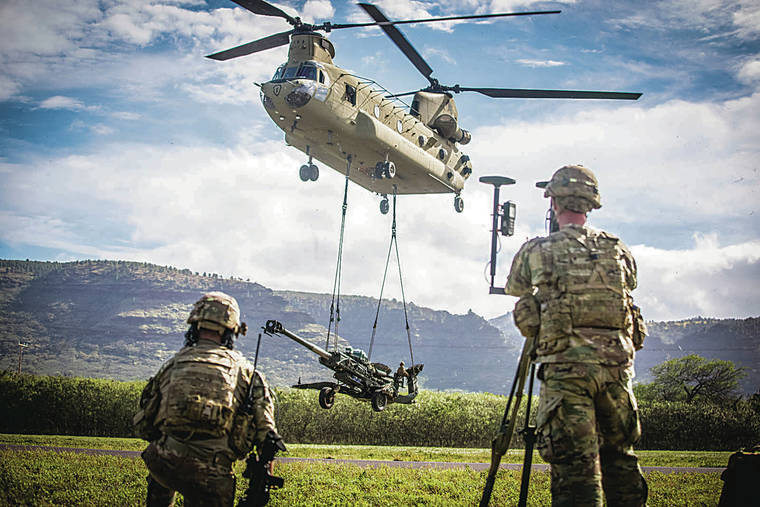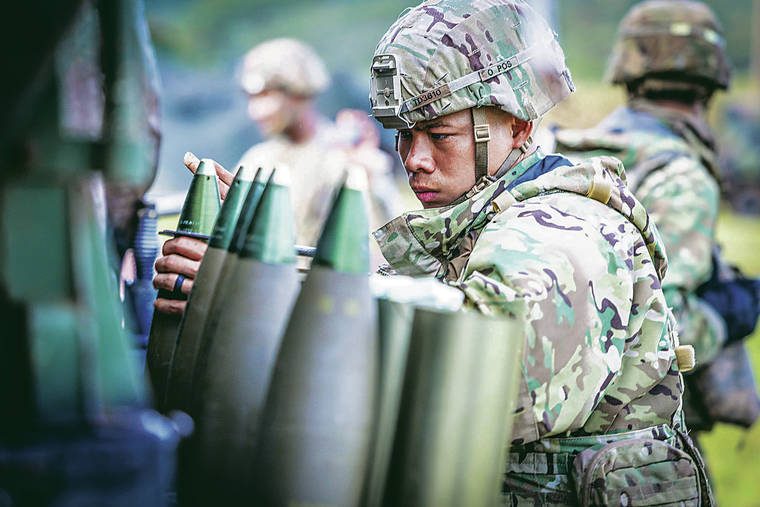Hawaii isn’t an island chain in the Western or South Pacific, but it is being used to replicate one for multiservice military training as the Army and Marines prepare to become a 21st-century island-hopping force to counter China.
A recent two-week Schofield Barracks exercise run by the 3rd Battalion, 7th Field Artillery called “Steel Crucible”
is a case in point. A total of
587 troops took part in the
Jan. 18-31 training, with about 60 Hawaii Marines within the total.
On Jan. 21 an Air Force C-17 cargo plane ferried soldiers and 105-mm howitzers from the Army’s Bravo Battery on Oahu to Pohakuloa Training Area on Hawaii island for what’s known as an “emergency deployment readiness exercise.”
The soldiers prepped, loaded up on the C-17, fired
at Pohakuloa and returned to Oahu — all within 24 hours, said 3-7 commander Lt. Col. John Gwinn.
That same night, soldiers and artillery Marines from Kaneohe Bay sling-loaded M777 155-mm howitzers from the Army and Marines beneath Marine Corps CH-53E Super Stallion helicopters to conduct live fire at Schofield in support of a simulated raid.
A few days later on
Jan. 27, Schofield used
CH-47 Chinook helicopters to drop off soldiers and howitzers at the Navy’s Pacific Missile Range Facility on Kauai for non-live-fire practice. Training at PMRF “is definitely new for our battalion,” Gwinn said.
It all fell within an island-
hopping scenario that was in the fictional nation of
Torbia but was facilitated by Hawaii’s natural geography. In this case the “near-peer” enemy possessed tanks and manned and unmanned
aircraft.
“Overall, this has been building over the last two years where it’s steady increments of learning in how we work best with our Marine Corps brethren and then try to expand with different aviation assets and naval assets as well, specifically for the (field artillery) battalion,” Gwinn said in an interview.
The 2018 National Defense Strategy shifted the U.S. national security focus from countering violent extremism to confronting revisionist powers — mainly China and Russia. The Pacific was branded the Pentagon’s priority theater.
“And so that focus probably takes context more when you consider the next war we probably fight will be large-scale ground combat operations, and that’s going to require a joint force,” Gwinn said.
The Army is moving rapidly to try to merge its capabilities with those of other services in the air, land, sea, space and cyber domains through what it calls multidomain operations. Other services are doing the same.
Long-range precision missiles and artillery are the
Army’s No. 1 modernization priority. Both the Army and Marines likely will be equipped with missiles that can sink ships at sea as part of fast-moving forces that deploy to islands that dot the Western Pacific.
The Army said it is in pursuit of a new midrange missile that can hit targets from 310 to 930 miles away — which could prove beneficial in the Pacific island chains.
“What a dilemma that would create for our adversary,” Brig. Gen. John Rafferty, director of a long-
range fires team, said in an Army-produced story in October. Rafferty was referencing China.
The Army also is pursuing a precision strike missile with a 300-mile range, extended range cannon artillery that can hurl shells
40 miles, and hypersonic missiles.
The Marine Corps is being equipped with Naval Strike and Tomahawk missiles. The service also is expected to create its first-ever Marine littoral regiment in
Hawaii in fiscal 2022 with 1,800 to 2,200 Marines. New stern-landing light amphibious warships are being devised to move 75 Marines and cargo around Pacific
islands.
Whether Army or Marine Corps, such forces would need to be highly mobile to avoid being targeted with an increasingly sophisticated array of Chinese missiles.
Carl Schuster, a retired Navy captain, former director of operations at U.S. Pacific Command’s Joint Intelligence Center and
adjunct professor at Hawaii Pacific University, said
Hawaii “is the perfect place to conduct such ‘shoot
and scoot’ island-hopping operations.”
“Hawaii is ideally positioned and its island chain dispersed sufficiently to
replicate the operational and tactical distances and challenges involved,” he said.
Schuster said he sees “a lot of positives for Hawaii and the U.S.” with more training and more resources coming to the state. “The training will be conducted far from tourist areas, so it should have minimum impact on our dominant commercial industry, tourism,” he said.
The primary negative concern centers on conducting the training in ways that protect the environment, he added.
Schuster said he thinks Army and Marine Corps units in Hawaii will begin
to receive long-range fire equipment by 2025. “It is part of their services’ transformation into lighter, faster and more powerful supporting fires to meet the challenges of peer-state threats in the Western Pacific,” he said.
The Army already is laying the groundwork for that future with exercises such as Steel Crucible.
The commander of the 3rd Brigade at Schofield — of which 3-7 Field Artillery
is a part — “definitely sees his fight as being able to
(operate) in the littorals (near-shore waters) and conduct some type of island-hopping campaign,” said Gwinn, who also commanded the exercise.
“And so what we definitely wanted to seize out
of Steel Crucible was our ability to quickly project combat power. So we did
operate off of three islands,” he said.
Gwinn thinks Hawaii is “extremely suitable” for
island-hopping practice. For the field artillery battalion to be able to send a fire mission approximately 75 nautical miles to a location such as Kauai, “I think that replicates exactly what we might be asked to do in an island-
hopping campaign,” he said.
Going out to Kauai “helped us validate that range,” and Gwinn thinks it “sets the training strategy for possibilities at Kauai (with) that rapid deployment and redeployment of our artillery.” More training there may be possible. About a month earlier an infantry battalion conducted an emergency deployment readiness exercise to PMRF, he said.
Steel Crucible represented the first joint air assault with Marine and Army aviation on a nighttime raid. The command and control of dispersed artillery units across the island chain also was a first.
Gwinn said it makes a lot of sense to train with the other services. “It makes those things that we might be asked to do in a real combat situation a little bit easier if we work them out beforehand,” he said. “So, for example, will our communications systems effectively talk with the Marine communications systems, Air Force, etc.? And part of this Steep Crucible exercise answered that flatly: Absolutely, they do.”




